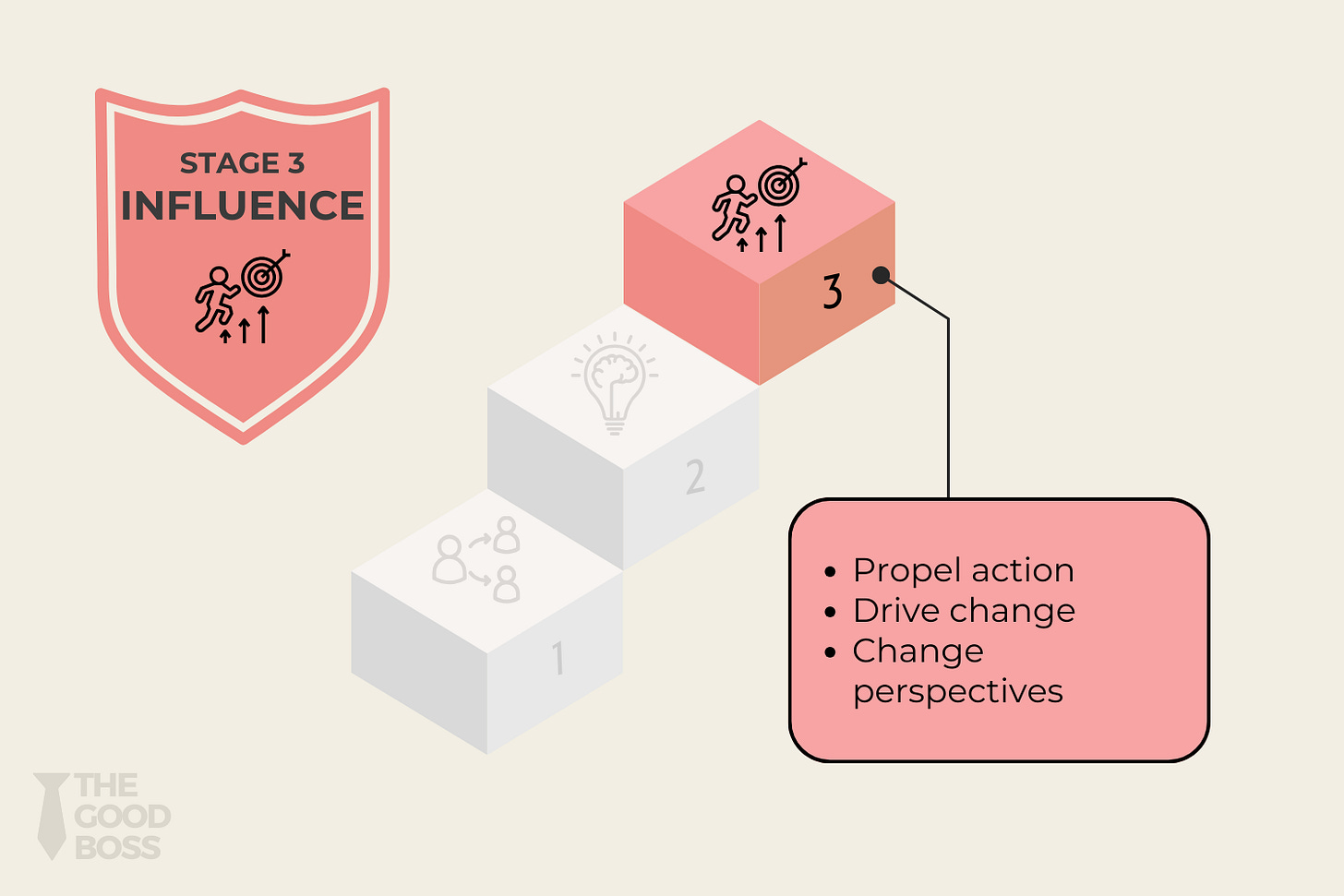The Three Stages of Communication in Leadership
How To Master The Art (and Craft) of Communication
In this issue:
Part 1: Understanding the Stages of Communication
What are the Three Stages?
The Interplay Between the Stages
Part 2: Applying the Three Stages of Communication
The 3-I Checklist for Impactful Communication
Real-Life Leadership Scenarios
The Three Stages of Communication Worksheet
Part 3: Going from here
Common Pitfalls and How to Avoid Them
Recommended Resources
Final Thoughts and Takeaways
✨
A few weeks ago, I found my 9-year-old son in tears, his Nintendo Switch 🎮 tossed aside. When I asked what was wrong, he wiped his face and cried, “I hate this game. I’ve been stuck on this level for DAYS.”
I sat down next to him, picked up the controller, and after a few tries, I felt the same thing.
The game wasn’t unfair – it was just hard. You had to get the timing right. Your moves had to be deliberate. The strategy had to evolve as the stage got more complex.
As I thought about this, it struck me that leadership communication is not much different.
We all start as rookies, just trying to survive. Over time, we figure out better ways to communicate. Some of us level up, while others get stuck in the same loop, repeating the same basic moves that no longer work.
But here’s the twist: unlike video games, communication doesn’t show you when you’re failing. Your team may continue to nod, smile, and say “Got it,” while drowning in confusion or resentment. And it’s not because you were quiet, but because you stayed at Stage 1, when the situation needed you to go further.
In this article, I will discuss the 3 Stages of Communication in Leadership, aka the 3 I’s (Inform, Inspire, Influence), and how you can navigate these stages to master the art (and craft) of communication.
Ready to dive in? Let’s go!
Part 1: Understanding the Stages of Communication
In this section, we’ll break down the 3 stages of communication, what they are, how they build on each other, and why most leaders get stuck at the first or second stage.
What are the Three Stages?
Let’s look at each stage, one by one.
Stage 1: Inform
“Power today comes from sharing information, not withholding it.” — Keith Ferrazzi
As a new gamer (or a gamer new to a game), you start as a rookie. Your focus is on staying alive, and as you play the game, you learn the rules, the nitty-gritties, and the tactics.
Similarly, as a leader, your first stage of communication is Inform.
At its core, informing involves laying out facts, data, and relevant information.
As a leader, you need to ensure your team members and stakeholders are kept updated with pertinent information, and are equipped with the knowledge that they need to get their job done.
Examples of informing:
Cascading information from leadership to your teams
Keeping leadership updated on progress made by your team on projects in flight
Sharing decision outcomes that impact your team or stakeholders
As you go about sharing information, you also need to be mindful of how you communicate.
Here are some common mistakes you want to avoid:
Overloading with Information: Leaders sometimes mistake informing for dumping every detail. Too much information overwhelms your team, diluting the key messages. Focus on relevance and clarity – not every email needs a 5-page attachment.
Lack of Transparency: Hoarding information or sugarcoating problems creates distrust. Your team values honesty, even if the news isn’t great. Transparent communication builds credibility and ensures alignment.
One-Way Communication: Informing isn’t just about speaking at people. If you aren’t opening space for feedback or questions, you are inviting for misunderstandings. Encourage dialogue and open conversation.
👉🏼 As a leader, your goal is to provide accurate, relevant, and timely information to your teams and your stakeholders.
Stage 2: Inspire
“A leader must inspire, or his team will expire.” — Orrin Woodword
In gaming, as you progress to the intermediate level, you learn some of the strategies and moves you weren’t aware of earlier.
Your focus shifts from staying alive to making progress.
Similarly, as a leader, the second stage of communication is Inspire.
Inspiration goes beyond just information sharing. When you inspire, you ignite passion, fuel motivation, and trigger positive emotions in your audience.
Examples of inspiring:
Sharing a compelling story that resonates with your team
Painting a vivid image of the future to inspire your team
Getting your teams excited about the shared goal or vision
In Big, Hairy, Audacious Goals (BHAGs): How Successful Leaders Drive Innovation, we discussed how you can develop inspirational goals for your organization.
When you inspire, you tap into the emotional dimension of communication. But you should watch out for some common pitfalls:
Forgetting the “Why”: Some leaders try to motivate by focusing solely on what needs to be done. But inspiration comes from the why. Without connecting tasks to a bigger purpose, your team won’t feel invested.
Relying on Words Alone: Inspiration isn’t just about giving a powerful speech or quoting Simon Sinek ;-). Your actions matter more. Leaders who don’t embody the vision they preach quickly lose credibility. Walk the talk.
Neglecting Individual Motivations: Not everyone is inspired by the same things. Get to know what drives each person on your team, and tailor your communication accordingly. Avoid a one-size-fits-all approach.
👉🏼 As a leader, your goal is to inspire your teams about the shared goals and vision, and to get them excited about what the future holds.
Stage 3: Influence
“The key to successful leadership today is influence, not authority.” — Ken Blanchard
In gaming, as you advance to the pro level, you come up with your unique strategies, which are then adopted by other gamers. Your focus shifts from making progress to creating new paths and strategies.
Similarly, Influence belongs to the advanced stage of communication in leadership.
While informing and inspiring lay the groundwork for communication, influence is the catalyst that propels action.
Remember: You can share all the information you have, and inspire your team all you want, but all that is for nothing if they fail to take action.
As a leader, you need to influence your team, your stakeholders, and your boss to shape opinions, attitudes, and behaviors.
Examples of communicating with influence:
Compelling others to change their perspective
Driving alignment toward a common goal or objective
Propelling others into action
Influence is the highest stage of communication, and it requires strategic thinking and a focus on the long-term objectives of the organization. However, you must watch out for some common traps:
Skipping Inform and Inspire: Influence doesn’t work in isolation. If you jump straight to influencing without laying the groundwork (informing and inspiring), your team may feel misled rather than led. Influence is most effective when built on trust and shared understanding.
Being Too Aggressive: Trying to force alignment or push decisions without involving others creates resistance. Influence is about collaboration and guiding people to arrive at the conclusion with you, not dragging them there.
👉🏼 As a leader, your goal should be to communicate with influence to drive change and alignment toward the corporate goals.
Bringing It Together: The 3 Stages
We discussed the three I’s, or stages, of communication in leadership:
Inform. Provide accurate and timely information to your team and stakeholders.
Inspire. Get your teams excited about the shared goals and vision.
Influence. Drive change and alignment towards corporate goals.
As you build your communication muscle, you should move up the stages. Eventually, you should be using all three I’s, and that’s where you need to appreciate the interplay between them.
Let’s look at that next.
The Interplay Between the Stages
Effective leaders balance all three aspects:
informing to create clarity,
inspiring to build energy, and
influencing to ensure progress and results.
It’s important to note that, while the three I’s serve distinct purposes, they are not mutually exclusive.
In reality, the three I’s often overlap and complement each other, and that further amplifies their impact.
As an example, if you are looking to inspire your team with a futuristic vision, you first need to make sure they have sufficient context and understand the objectives. In that sense, informing serves as a foundation for inspiration.
Similarly, if your team is well-informed, you can use inspiration to bring meaning and purpose to their goals. And to take that a step further, you can use influence to drive their energy towards concrete action towards those goals.
Another way to understand the interplay between these three stages is their primary drivers:
When you inform, your communication is driven by facts
When you inspire, your communication is driven by emotions
When you influence, your communication is driven by action
At the end of the day, communication is a tool, and you need to be intentional and strategic in your communication.
Enjoying the read? Hit the ❤️ button and share/restack ♻️ it with others who might find it helpful.
Also, I’d love your feedback! 💬 Leave a quick testimonial here, and as a thank-you, I’ll send you a free copy of my book! It only takes a couple of minutes - thank you! 🙏
Part 2: Applying the Three Stages of Communication
In this section, you will learn how to apply the 3 Stages of Communication in your role as a leader.
We will start by reviewing the 3-I Checklist for Impactful Communication, a simple mental model to use before any important conversation for maximum impact.
We will then discuss some common real-life leadership scenarios, and how the 3 stages of communication play a critical role in the outcome.
Finally, we will make it real with the 3 Stages of Communication Worksheet, which will help you build your muscle in using and navigating the 3 stages in your leadership communication.
The 3-I Checklist for Impactful Communication
How do you ensure you are leveraging the three I’s of communication?
Here’s a simple checklist to run your message through before your next team meeting, 1:1, stakeholder update, or even a Slack message:








